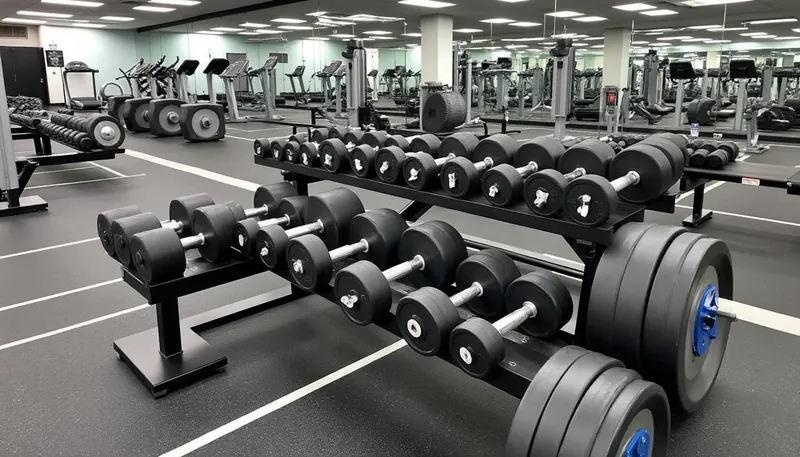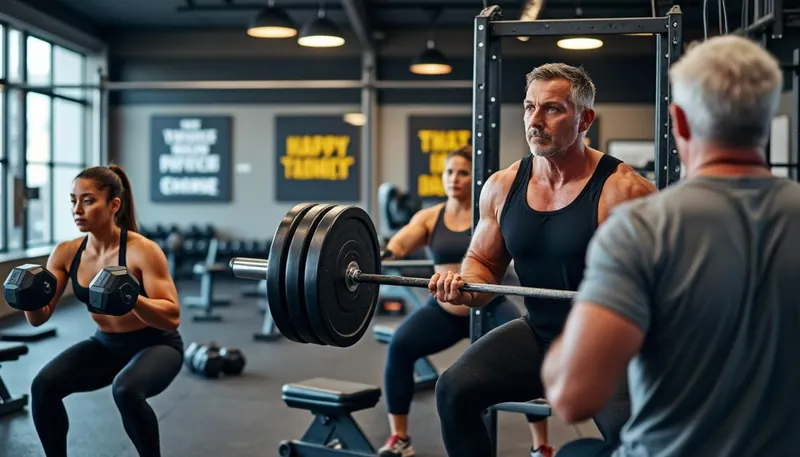When you step into the gym for the first time, the array of equipment can be overwhelming. The bright machines stand stoically, beckoning with their polished finish, while over in the corner, the free weights create a sense of raw power and freedom. If you’ve ever felt that wave of confusion wash over you, wondering which route to take — machines or free weights — you’re not alone. Every year, beginners grapple with this decision and it’s not just about preferences. The choice can affect your strength-building journey in profound ways. By 2025, fitness trends indicate that understanding these differences has only grown in importance, especially as people become increasingly focused on effective and safe workout routines. In this exploration, we’ll dissect the benefits and drawbacks of both systems while steering you toward making an informed decision tailored for your fitness goals and comfort level.
In short, whether you lean toward the structured environment provided by machines or the dynamic nature of free weights, it’s about alignment with your personal fitness journey. With the continuous evolution of fitness technology and the rise of innovative products from brands like Bowflex, Nautilus, and Rogue Fitness, your workout options have never been more diverse. Consideration of factors such as safety, muscle engagement, ease of use, and cost will empower you to choose the right path on your journey toward strength and health.
Understanding Free Weights: The Unleashed Potential
Choosing free weights is akin to opening the doors to a world of potential. Free weights encompass dumbbells, kettlebells, and barbells – any piece of equipment that isn’t fixed to a specific machine. It’s a more dynamic approach that challenges you to engage stabilizing muscles, which plays a crucial role in building functional strength.
The Benefits of Free Weights
One significant advantage of free weights is their capacity to work multiple muscle groups simultaneously. When performing an exercise like a dumbbell squat, not only are you targeting your legs, but you’re also activating your core and improving your balance. According to a study in 2023, beginners who utilized free weights saw more significant gains in overall strength compared to those confined to machines, primarily because free weights require more muscle coordination and engagement.
Consider the following points that illustrate the advantages of free weights:
- 🎯 Muscle Engagement: Engages multiple muscle groups for effective training.
- 💪 Functional Strength: Activities mimic daily movements, enhancing real-life functionality.
- 💰 Cost-Effective: A minimal investment (for example, a set of dumbbells can range from $20-$50) allows access to a wide exercise variety.
- 📊 Progression: As you grow stronger, you can continuously challenge yourself with different exercises and weights.
Potential Downsides of Free Weights
That said, embarking on a free weight routine is not without its challenges. The primary concern is safety. Beginners might struggle with maintaining proper form or lifting weights that are too heavy, potentially resulting in injuries.
Here’s what to keep in mind:
- ⚠️ Form and Technique: Without guidance, incorrect lifting can lead to injuries.
- 💡 Intimidation Factor: The free weight section can feel intimidating for newcomers, leading to hesitation.
- 🤕 Risk of Injury: Especially if lifting heavy without adequate knowledge of form.
Pro tip: If you opt to begin with free weights, starting light (5–10 lbs) and focusing on form can ease the transition. You might even consider an AI-Powered Workout Plan, which tailors exercises based on your level, keeping you safe and effective on your journey.

Machines: The Safety Net for Beginners
On the other side of the gym, machines present a tempting offer for beginners, especially those who are new to strength training. They guide the user through a predetermined motion, which can feel much safer as it limits the range of movement and helps in maintaining proper form.
The Advantages of Machines
Machines can offer several advantages, particularly for those just starting out. By guiding your movements, they help you build foundational strength without the increased risk associated with free weights.
- 🦾 Stability: Machines provide support, allowing users to focus solely on the target muscle. For instance, seated leg presses target your quads without worrying about balance.
- 📚 User-Friendly: Most machines come with instructional guides and weight adjustments making them straightforward to use.
- 👨⚕️ Lower Injury Risk: Research from 2020 indicated machines present a lower risk of injury, especially for beginners compared to free weights.
- 🏠 Compact for Home Use: Many home gym systems from brands like Life Fitness and Technogym provide multifunctional machines that can serve multiple purposes.
Disadvantages of Machines
Despite their benefits, machines are not without their drawbacks. One of the biggest criticisms is a lack of functional training, as they often isolate muscle groups rather than work them in concert with others, which might limit overall muscular development.
- 🔍 Isolation: Machines typically let you isolate a specific muscle, which might not be conducive to overall functional gains.
- 👮♂️ Limited Variety: Your workout is constrained by the designs of the machines available; for example, you won’t find a leg press machine in a small apartment.
- 🤖 Bulky: Machines take up significant space, which makes them less practical for home gyms compared to a set of dumbbells.
As you explore machines, utilizing them to learn movements before transitioning to free weights is a smart strategy. This method builds confidence and solidifies proper technique, paving a smoother path for future workouts.

Free Weights vs. Machines: A Detailed Comparison
So, which option is better for you? We’ve highlighted key aspects to consider when weighing your options. Here’s a handy comparison chart to help clarify the benefits and drawbacks accordingly.
| Characteristic | Free Weights | Machines |
|---|---|---|
| Muscle Engagement | 🟢 Engages multiple muscle groups | 🔵 Isolates target muscles |
| Ease of Use | ⚠️ Requires good form practices | ✅ User-friendly with guided movements |
| Safety | 🤕 Higher risk without guidance | 🛡️ Lower risk; more forgiving |
| Cost | 💵 Generally cheaper | 💰 More expensive for home setups |
| Progression | 🔄 Huge variety for progress | 📉 Potentially limited by machine design |
Through this, it’s clear that both options come with their unique benefits and challenges, and your choice should align with your fitness goals and comfort level.
Top Tips for Choosing the Right Gear
If you’re still feeling a bit conflicted about where to begin your journey, consider what’s right for you. Whether you lean toward machines for a structured environment or yearn for the freedom of free weights, the perfect choice reflects your individual fitness aspirations.
Things to Consider for Your Decision
- ✨ Beginner-Friendly: Choose machines if you’re new, nervous, or want to focus on one muscle group at a time.
- 🏋️ Full-Body Strength: Consider free weights if you wish to build overall strength or have experienced guidance.
- 🔄 Mix It Up: Many fitness professionals recommend combining both methods for a well-rounded approach.
- 🎯 Check Your Goals: Are you leaning towards aesthetics or functional strength? Clarifying your priorities helps guide your choice.
- 📱 Use Tech: Pair either method with tech-based plans to receive custom routines that match your level.
Remember, everyone’s fitness journey is unique. Consider trying a few sessions of both machines and free weights, and see how your body responds. Your comfort, enjoyment, and effectiveness will ultimately guide you on your path.
Tracking Your Progress: Beyond the Scale
As you embark on this fitness journey, measuring your progress goes beyond merely stepping on a scale. Understanding your strength advancements requires tracking various metrics. This insights-driven approach ensures you’re gaining strength and improving overall wellness.
Here are some vital metrics to consider:
- 📈 Lift Progression: Record the weights you can lift over time to visibly see your strength gains.
- 🗓️ Frequency of Workouts: Monitor how often you engage with weights, noting improvement in form and confidence.
- 💡 Endurance Levels: Assess how workouts feel as you progress; more strength typically allows you to do more.
- 🌟 Body Measurements: Track circumferences (like biceps or waist) for a clearer picture of changes in body composition.
Engaging with Your Fitness Journey
Ultimately, whether you gravitate towards free weights, machines, or a combination of both, the crucial factor remains consistency and enjoyment. Keeping your workouts engaging and aligning them with your lifestyle can rapidly transform how you see your fitness journey. So, how do you feel about your choices? Which workout gear excites you the most?
Are machines or free weights better for beginners?
It largely depends on personal preference, safety considerations, and fitness goals. Machines may be safer, while free weights engage additional muscles for strength development.
How much should I lift as a beginner?
Starting with lighter weights to focus on form is crucial. Aim for weights that allow you to complete 10-15 reps comfortably before increasing.
Can I use both machines and free weights?
Absolutely! Many experts recommend combining both for a balanced workout routine.
How can I track my progress?
Consider logging your weight lifts, workout frequency, and even measurements to see tangible improvements in your fitness journey.
Which brands are good for home workout equipment?
Brands like Bowflex, Body-Solid, and Hammer Strength offer reliable equipment worth considering for home use.


